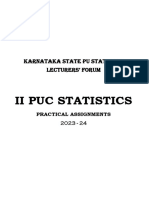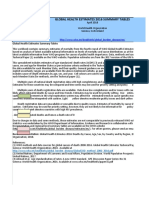Assignment.doc
Uploaded by
Obsa AbrahimAssignment.doc
Uploaded by
Obsa AbrahimEpidemiology Course
Due date: Nov 08, 2024; Name: __________________________________________________
A study was conducted to determine cervical mortality among women in three woredas
(refer table below)
Woreda Age group
15-24 25-44 45+ Total
A Population 300 400 700 1400
Cases 32 80 400 512
Mortality rate
B Population 400 600 400 1400
Cases 80 177 255 512
Mortality rate
C Population 700 400 300 1400
Cases 165 135 212 512
Mortality rate
Q1. A. Which woreda has the highest prevalence based on the observed crude mortality rate?
B. Do you recommend standardization for this study is important? Why?
ONLY HAND WRITTEN ANSWERES ON THE QUESTION SHEET ARE ACCEPTED
Epidemiology Course
Due date: Nov 08, 2024; Name: __________________________________________________
For questions 2 to 4 use the following table:
Q2. If you are consulted to give advice of comparing woredas A, B and C having the data below,
what type of standardization would you advise? Why?
Q3. Compute the appropriate standardization.
Woreda Age group
15-24 25-44 45+ Total
A Population 300 400 700 1400
Cases 512
Mortality rate
B Population 400 600 400 1400
Cases 512
Mortality rate
C Population 700 400 300 1400
Cases 165 135 212 512
Mortality rate
Q4.A. Based on the standardization you use, which woreda has highest mortality? Where would
you advice people to live in order to minimize their risk of death?
B. Interpret your findings!
ONLY HAND WRITTEN ANSWERES ON THE QUESTION SHEET ARE ACCEPTED
Epidemiology Course
Due date: Nov 08, 2024; Name: __________________________________________________
For questions 5 to 6 use the following table:
Q5. Do direct standardization using mortality rate for woreda “A” as the standard population.
Woreda Age group
15-24 25-44 45+ Total
A Population 400 600 1000 2000
Cases 30 80 400 510
Mortality rate
B Population 500 800 700 2000
Cases 80 175 255 510
Mortality rate
C Population 700 800 500 2000
Cases 165 135 210 510
Mortality rate
Q6. A. Based on the standardization you use, which woreda has highest mortality? Where would
you advice people to live in order to minimize their risk of death?
B. Interpret your finding!
ONLY HAND WRITTEN ANSWERES ON THE QUESTION SHEET ARE ACCEPTED
Epidemiology Course
Due date: Nov 08, 2024; Name: __________________________________________________
1. On 4th September 1999, the Woreda Health Manager (WHM) of Shola woreda received a
report of an epidemic of unknown disease that had affected villages 1 and 2 in the woreda. He
was informed that the sick were presenting with sudden onset of vomiting, weakness and acute
watery diarrhoea. Two people had already from the disease. On further investigation it was
noted that the index cases were seen two days ago.
• What would be the case definition?
• How does the WHM verify the existence of an epidemic of cholera?
The woreda epidemic management committee did a thorough investigation and collected the data
that is summarized in the table below.
Table. Cases and deaths of cholera in Shola, from 1st to 14th September 1999.
Date Cases Deaths
1st 2 1
2nd 2 1
3rd 8 0
4th 4 0
5th 5 0
6th 3 0
7th 0 0
8th 1 0
9th 4 0
10th 2 0
11th 5 0
12th 5 0
13th 5 0
14th 2 0
Total 48 2
• Draw a graph to show epidemic of cholera in Shola using the data provided in the above
table.
• Describe the graph since the onset of the first case. How do you explain the multiple peaks
seen in the graph?
ONLY HAND WRITTEN ANSWERES ON THE QUESTION SHEET ARE ACCEPTED
Epidemiology Course
Due date: Nov 08, 2024; Name: __________________________________________________
The Woreda epidemic management team also summarized the cases of cholera by locality and sex
as seen in the table below.
Table 2. Distribution of cases by villages and sex, in Shola woreda.
Villages Population Cases of cholera Total cases Attack rate
at risk per 100,000
Male Female
1 30,000 12 7 19
2 20,000 12 3 15
3 40,000 4 9 13
4 10,000 0 1 1
Total 100,000 28 20 48
• Did the disease equally affect males and females? (assume male to female ratio is 1:1)
• Calculate the attack rate for each village, in Shola woreda.
Refers to table 3. What age groups were most affected by cholera?
Table3. Distribution of cases by age
Age groups Population at risk Number of cases Attack rate per
100,000 population
0-4 20,000 10
5-9 15,000 17
10-14 15,000 11
15-19 10,000 6
20 and above 40,000 4
• Based on your answers to previous questions what hypothesis could you make regarding
the place and the group at risk of getting the disease in Shola woreda?
ONLY HAND WRITTEN ANSWERES ON THE QUESTION SHEET ARE ACCEPTED
You might also like
- Herb Dewey - Mindblowing Psychic Readings OCRd82% (11)Herb Dewey - Mindblowing Psychic Readings OCRd72 pages
- Community Medicine Department: Osmania Medical College Hyderabad U.G. Statistical ExercisesNo ratings yetCommunity Medicine Department: Osmania Medical College Hyderabad U.G. Statistical Exercises13 pages
- An Epidermic Disease in South Carolina Assignment100% (1)An Epidermic Disease in South Carolina Assignment10 pages
- Maternal Mortality Rates Report For 2022No ratings yetMaternal Mortality Rates Report For 20225 pages
- 2021 batch model B batch practical questionsNo ratings yet2021 batch model B batch practical questions16 pages
- Lecture 10 - Intro - To - Biostatistics MEASURE of FREQUENCYpptNo ratings yetLecture 10 - Intro - To - Biostatistics MEASURE of FREQUENCYppt49 pages
- Ospe Statistics and Occupational HealthNo ratings yetOspe Statistics and Occupational Health21 pages
- 2019. A scientific note on the effect of oxalic acid on honey bee larvaeNo ratings yet2019. A scientific note on the effect of oxalic acid on honey bee larvae6 pages
- Collaborative Course On Infectious Diseases: Lecture # 4 Dengue FeverNo ratings yetCollaborative Course On Infectious Diseases: Lecture # 4 Dengue Fever54 pages
- Fiji Leptospirosis Clinical Guidelines - 10JUN - FINALNo ratings yetFiji Leptospirosis Clinical Guidelines - 10JUN - FINAL25 pages
- Global Health Estimates 2019 Summary Tables: Deaths by Cause, Age and Sex, by World Bank Income Group, 2000-2019No ratings yetGlobal Health Estimates 2019 Summary Tables: Deaths by Cause, Age and Sex, by World Bank Income Group, 2000-201942 pages
- MPH 604 Week 2 Rate Calculations AssignmentNo ratings yetMPH 604 Week 2 Rate Calculations Assignment5 pages
- 17 Person-Years of Healthy Time For This Population 11.76 Incidence Density Is 11.76 Per 100No ratings yet17 Person-Years of Healthy Time For This Population 11.76 Incidence Density Is 11.76 Per 1006 pages
- II PU Statistics Practical Assigments-2023No ratings yetII PU Statistics Practical Assigments-202326 pages
- STAT 456 DEMOGRAPHY AND POPULATION STUDY - Kabarak UniversityNo ratings yetSTAT 456 DEMOGRAPHY AND POPULATION STUDY - Kabarak University6 pages
- General Epidemiology Problems Set 2 05.03.2024No ratings yetGeneral Epidemiology Problems Set 2 05.03.20244 pages
- II PU Statistics Practical Assigments-2023 AssociationNo ratings yetII PU Statistics Practical Assigments-2023 Association26 pages
- Laryngeal Cancer, Risk Factors, Symptoms and Treatment PDFNo ratings yetLaryngeal Cancer, Risk Factors, Symptoms and Treatment PDF8 pages
- 6/22/2008 Holocaust Survivors in Israel: Population Estimates and Utilization of Services For Nursing Care at HomeNo ratings yet6/22/2008 Holocaust Survivors in Israel: Population Estimates and Utilization of Services For Nursing Care at Home14 pages
- II PU Statistics Practical Assigments-2023No ratings yetII PU Statistics Practical Assigments-202326 pages
- Presentation Slides Intepretation of Research Findings Part 1No ratings yetPresentation Slides Intepretation of Research Findings Part 170 pages
- Update On COVID-19 in Canada: Epidemiology and ModellingNo ratings yetUpdate On COVID-19 in Canada: Epidemiology and Modelling22 pages
- Update On COVID-19 in Canada: Epidemiology and ModellingNo ratings yetUpdate On COVID-19 in Canada: Epidemiology and Modelling22 pages
- New Tools For Recognizing TB (Molecular Testing) (Dr. Mark Perkins)No ratings yetNew Tools For Recognizing TB (Molecular Testing) (Dr. Mark Perkins)71 pages
- Submitted To: Arooj Butt Submitted By: Rehab Abid ROLL NO: M-17940No ratings yetSubmitted To: Arooj Butt Submitted By: Rehab Abid ROLL NO: M-1794013 pages
- Imunisasi Pada Kesehatan Masyarakat Di Indonesia Dan Pelaksanaan Safe InjectionNo ratings yetImunisasi Pada Kesehatan Masyarakat Di Indonesia Dan Pelaksanaan Safe Injection90 pages
- Group Assignment for Course Inclusiveness(SNIE 1012)100% (1)Group Assignment for Course Inclusiveness(SNIE 1012)2 pages
- Process Mapping and Value Stream MappingNo ratings yetProcess Mapping and Value Stream Mapping24 pages
- Diversey Suma Multi d2 3l Cleaner ConcentrateNo ratings yetDiversey Suma Multi d2 3l Cleaner Concentrate2 pages
- Critical Success Factors in Projects PinNo ratings yetCritical Success Factors in Projects Pin20 pages
- Worksheet 26 Pronouns and Their AntecedentsNo ratings yetWorksheet 26 Pronouns and Their Antecedents2 pages
- Lecture 3 - Bohr Models - Success and Its FailureNo ratings yetLecture 3 - Bohr Models - Success and Its Failure31 pages
- Dying A Social Perspective On The End of Life Alex Broom Download PDF100% (8)Dying A Social Perspective On The End of Life Alex Broom Download PDF65 pages
- Export Mktg. PPT Slides (18!10!2020) (Dr. DHOND)No ratings yetExport Mktg. PPT Slides (18!10!2020) (Dr. DHOND)94 pages
- Damage To Genital Tract, Tears, Uterine Rupture, Episiotomy, Shock in ObstetricsNo ratings yetDamage To Genital Tract, Tears, Uterine Rupture, Episiotomy, Shock in Obstetrics12 pages
- Instant Access to Emotions as Original Existences: A Theory of Emotion, Motivation and the Self 1st ed. Edition Demian Whiting ebook Full ChaptersNo ratings yetInstant Access to Emotions as Original Existences: A Theory of Emotion, Motivation and the Self 1st ed. Edition Demian Whiting ebook Full Chapters41 pages
- Community Medicine Department: Osmania Medical College Hyderabad U.G. Statistical ExercisesCommunity Medicine Department: Osmania Medical College Hyderabad U.G. Statistical Exercises
- Lecture 10 - Intro - To - Biostatistics MEASURE of FREQUENCYpptLecture 10 - Intro - To - Biostatistics MEASURE of FREQUENCYppt
- 2019. A scientific note on the effect of oxalic acid on honey bee larvae2019. A scientific note on the effect of oxalic acid on honey bee larvae
- Collaborative Course On Infectious Diseases: Lecture # 4 Dengue FeverCollaborative Course On Infectious Diseases: Lecture # 4 Dengue Fever
- Fiji Leptospirosis Clinical Guidelines - 10JUN - FINALFiji Leptospirosis Clinical Guidelines - 10JUN - FINAL
- Global Health Estimates 2019 Summary Tables: Deaths by Cause, Age and Sex, by World Bank Income Group, 2000-2019Global Health Estimates 2019 Summary Tables: Deaths by Cause, Age and Sex, by World Bank Income Group, 2000-2019
- 17 Person-Years of Healthy Time For This Population 11.76 Incidence Density Is 11.76 Per 10017 Person-Years of Healthy Time For This Population 11.76 Incidence Density Is 11.76 Per 100
- STAT 456 DEMOGRAPHY AND POPULATION STUDY - Kabarak UniversitySTAT 456 DEMOGRAPHY AND POPULATION STUDY - Kabarak University
- II PU Statistics Practical Assigments-2023 AssociationII PU Statistics Practical Assigments-2023 Association
- Laryngeal Cancer, Risk Factors, Symptoms and Treatment PDFLaryngeal Cancer, Risk Factors, Symptoms and Treatment PDF
- 6/22/2008 Holocaust Survivors in Israel: Population Estimates and Utilization of Services For Nursing Care at Home6/22/2008 Holocaust Survivors in Israel: Population Estimates and Utilization of Services For Nursing Care at Home
- Presentation Slides Intepretation of Research Findings Part 1Presentation Slides Intepretation of Research Findings Part 1
- Update On COVID-19 in Canada: Epidemiology and ModellingUpdate On COVID-19 in Canada: Epidemiology and Modelling
- Update On COVID-19 in Canada: Epidemiology and ModellingUpdate On COVID-19 in Canada: Epidemiology and Modelling
- New Tools For Recognizing TB (Molecular Testing) (Dr. Mark Perkins)New Tools For Recognizing TB (Molecular Testing) (Dr. Mark Perkins)
- Submitted To: Arooj Butt Submitted By: Rehab Abid ROLL NO: M-17940Submitted To: Arooj Butt Submitted By: Rehab Abid ROLL NO: M-17940
- Imunisasi Pada Kesehatan Masyarakat Di Indonesia Dan Pelaksanaan Safe InjectionImunisasi Pada Kesehatan Masyarakat Di Indonesia Dan Pelaksanaan Safe Injection
- Pathological Lives: Disease, Space and BiopoliticsFrom EverandPathological Lives: Disease, Space and Biopolitics
- Group Assignment for Course Inclusiveness(SNIE 1012)Group Assignment for Course Inclusiveness(SNIE 1012)
- Dying A Social Perspective On The End of Life Alex Broom Download PDFDying A Social Perspective On The End of Life Alex Broom Download PDF
- Damage To Genital Tract, Tears, Uterine Rupture, Episiotomy, Shock in ObstetricsDamage To Genital Tract, Tears, Uterine Rupture, Episiotomy, Shock in Obstetrics
- Instant Access to Emotions as Original Existences: A Theory of Emotion, Motivation and the Self 1st ed. Edition Demian Whiting ebook Full ChaptersInstant Access to Emotions as Original Existences: A Theory of Emotion, Motivation and the Self 1st ed. Edition Demian Whiting ebook Full Chapters

































































































